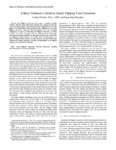Filters: Format: "application/pdf" School Or College: "College of Engineering" Collection: "ir_uspace"
| Creator | Title | Description | Subject | Date | ||
|---|---|---|---|---|---|---|
| 1 |
 | Liu, Feng | (BAl12)Cs: a cluster-assembled solid | First-principles calculations on the geometry and stability of AlnBm clusters have been carried out to examine the effect of size, composition, and electronic-shell filling on their relative stability. It is shown that although Al and B are both trivalent, a BAl12 cluster is more stable than an Al1... | First-principles calculations; (BAl12)Cs; Cluster-assembled; AlnBm clusters | 1997-06 |
| 2 |
 | Normann, Richard A.; Campbell, Patrick K.; Jones, Kelly E. | 100 electrode intracortical array: structural variability | A technique has been developed for fabricating three dimensional "hair brush" electrode arrays from monocrystalline silicon blocks. Arrays consist of a square pattern of 100 penetrating electrodes, with 400 microns interelectrode spacing. Each electrode is 1.5mm in length and tapers from about 100 m... | Microelectrode arrays; Stimulation; Micromachining | 1990 |
| 3 |
 | Furse, Cynthia M. | 13 crazy, notorious things to do in an EM class | The average attention span of an adult human is 12-20 minutes. Our lectures are 50-80 minutes. Attention Span Math reminds us to take a break now and then, and to bring the class back to life by bringing some life to the class. Many students learn things better if they can see and touch them, so thi... | Attention span; Fun | 2005-06 |
| 4 |
 | Henderson, Thomas C. | 2-D scene analysis using split-level relaxation | We present a new method for applying multiple semantic constraints based on discrete relaxation. A separate graph is maintained for each constraint relation and used in parallel to achieve a consistent labeling. This permits both local and global analysis without recourse to complete graphs. Here l... | Discrete relaxation; Split-level relaxation | 1985 |
| 5 |
 | Bhanu, Bir | 3-D model building for computer vision | This paper presents a Computer-Aided Geometric Design (CAGD) based approach for building 3-D models which can be used for the recognition of 3-D objects for industrial machine vision applications. The objects are designed using the Alpha_1 CAGD system developed at the University of Utah. A new metho... | CAGD; 3-D models; Machine vision | 1985 |
| 6 |
 | Gooch, Amy A.; Gooch, Bruce; Willemsen, Peter; Kniss, Joe; Riesenfeld, Richard F.; Shirley, Peter S. | 3D Line textures and the visualization of confidence in Architecture | This work introduces a technique for interactive walkthroughs of non-photorealistically rendered (NPR) scenes using 3D line primitives to define architectural features of the model, as well as indicate textural qualities. Line primitives are not typically used in this manner in favor of texture ma... | Presentation graphics; Interactive walkthroughs | 2007 |
| 7 |
 | Furse, Cynthia M. | 3D ray-tracing for intra-vehicle environments | In order to develop a wireless communication system that could be used for all types of aircraft sensor networks, the severe multipath channel found inside aircrafts must be well defined. This multipath channel is much more complex than usual outdoor/indoor channels and thus far, research has been l... | 2009 | |
| 8 |
 | Khan, Faisal Habib | 5 kW multilevel DC-DC converter for hybrid electric and fuel cell automotive applications | A 5 kW multilevel modular capacitor clamped dc-dc converter (MMCCC) for future hybrid electric vehicle and fuel cell automotive applications will be presented in this paper. The modular structure of the MMCCC topology was utilized to build this 5 kW converter with high reliability and fault bypassi... | 2007-09 | |
| 9 |
 | Blair, Steven | A 3D glass optrode array for optical neural stimulation | This paper presents optical characterization of a first-generation SiO2 optrode array as a set of penetrating waveguides for both optogenetic and infrared (IR) neural stimulation. Fused silica and quartz discs of 3-mm thickness and 50-mm diameter were micromachined to yield 10×10 arrays of up to 2-... | 2012-01-01 | |
| 10 |
 | Khan, Faisal Habib | A 5 kW Bi-directional multilevel modular DC-DC converter (MMCCC) featuring built in power management for fuel cell and hybrid electric automobiles | Abstract- A new capacitor clamped modular dc-dc converter with bi-directional power handling capability will be presented in this paper. This inductor-free design is modular, and it is possible to integrate multiple loads and sources simultaneously in the converter. Moreover, this 5 kW dc-dc convert... | 2007 | |
| 11 |
 | Mathews, V. John | A baseband residual vector quantization algorithm for voiceband data signals | Abstract-In this paper, we present a new approach to the digitization and compression of a class of voiceband modem signals. Our approach, which we call baseband residual vector quantization (BRVQ), relies heavily upon the simple structure present in a modem signal. After the signal is converted to... | 1989 | |
| 12 |
 | Mathews, V. John; Schlegel, Christian | A blind adaptive projection receiver for CDMA systems | Abstract - This paper presents a blind and adaptive CDMA receiver that does not require knowledge of the spreading codes associated with users other than the ones of interest. Receivers for synchronous as well as asynchronous transmission by multiple users with error control coding are develope... | 1998 | |
| 13 |
 | Mathews, V. John; Schlegel, Christian | A blind projection receiver for coded CDMA systems | ABSTRACT This paper presents a blind adaptive CDMA receiver that requires no knowledge of the spreading codes, the delays, and the energy of the received signals associated with the interfering users. Our receiver is based on linear interference cancellation and adaptive interference signal subspa... | 1999 | |
| 14 |
 | Poeppelmeier, Charles Christian | A boolean sum interpolation scheme to random data for computer aided geometric design | This thesis presents a new imterpolation function for randomly distributed data. The new interpolation function is capable of exactly reproducing quadratic surfaces. The new function is developed, through boolean sum theory, from Shepard's two dimensional interpolation functions and the Barnhill-Gre... | Computer-aided geometric design; CAGD; Barnhill-Gregory; Interpolation functions | 1975 |
| 15 |
 | Ziegenfuss, Donna | A Busy Professor's Guide to Sanely Flipping Your Classroom | The Flipped Classroom has become a popular teaching method. Students watch video lectures before class, saving class time for active learning (problem solving, demonstrations, applications, etc.). This paper is a useful guide for busy professors who would like to try out the flipped classroom approa... | flipped classroom; inverted classroom; engineering education; teaching electromagnetics; assessment pedagogy | 2019 |
| 16 |
 | Furse, Cynthia M. | A busy professors guide to sanely flipping your classroom | This paper describes the use of the flipped classroom approach for an Introduction to Electromagnetics course. Video lectures were created on a tablet PC, and uploaded to YouTube. Students watched the videos before coming to class. Class time was used for problem solving strategy (using homework as ... | 2013-01-01 | |
| 17 |
 | Balasubramonian, Rajeev | A case for increased operating system support in chip multi-processors | We identify the operating system as one area where a novel architecture could significantly improve on current chip multi-processor designs, allowing increased performance and improved power efficiency. We first show that the operating system contributes a non-trivial overhead to even the most com... | 2005 | |
| 18 |
 | Brunvand, Erik L. | A case for increased operating system support in chip multi-processors | We identify the operating system as one area where a novel architecture could significantly improve on current chip multi-processor designs, allowing increased performance and improved power efficiency. We first show that the operating system contributes a non-trivial overhead to even the most com... | 2005 | |
| 19 |
 | Panangaden, Prakash | A category theoretic formalism for abstract interpretation | We present a formal theory of abstract interpretation based on a new category theoretic formalism. This formalism allows one to derive a collecting semantics which preserves continuity of lifted functions and for which the lifting functon is itself continuous. The theory of abstract interpretation i... | Formal theory; Theoretic formalism; Lifted functions | 1984 |
| 20 |
 | Brunvand, Erik L. | A cell set for self-timed design using actel FPGAs | Asynchronous or self-timed systems that do not rely on a global clock to keep system components synchronized can offer significant advantages over traditional clocked circuits in a variety of applications. However, these systems require that suitable self-timed circuit primitives are available for b... | Self-timed systems; Actel field programmable gate arrays; FPGA | 1991 |
| 21 |
 | Davis, Alan L. | A characterization of parallel systems | a taxonomy for parallel processing systems is presented which has some advantages over previous taxonomies. The taxonomy characterizes parallel processing systems using four parameters: topology, communication, granularity, and operation. These parameters and used repetitively in a hierarchical fash... | Parallel systems | 1980 |
| 22 |
 | Mathew, Binu K.; Davis, Al | A characterization of visual feature recognition | Natural human interfaces are a key to realizing the dream of ubiquitous computing. This implies that embedded systems must be capable of sophisticated perception tasks. This paper analyzes the nature of a visual feature recognition workload. Visual feature recognition is a key component of a numb... | Visual feature recognition; Human interfaces | 2003-09-03 |
| 23 |
 | Chen, Yang; Regehr, John | A code size microbenchmark for C | Motivation ? No compilers could always generate smaller code than others ? Hand-optimized code is often hard to understand ? Programmers tend to write readable code and trust compilers generate fast and compact code for them ? There is a plenty of room for improving compiler optimizations Our ... | ||
| 24 |
 | Carter, John | A collective approach to harness idle resources | We propose a collective approach for harnessing the idle resources (cpu, storage, and bandwidth) of nodes (e.g., home desktops) distributed across the Internet. Instead of a purely peer-to-peer (P2P) approach, we organize participating nodes to act collectively using collective managers (CMs). Pa... | Idle resources; Computer nodes | 2008 |
| 25 |
 | Kessler, Robert R. | A communication-ordered task graph allocation algorithm | The inherently asynchronous nature of the data flow computation model allows the exploitation of maximum parallelism in program execution. While this computational model holds great promise, several problems must be solved in order to achieve a high degree of program performance. The allocation and ... | Task graph allocation algorithm | 1992 |
